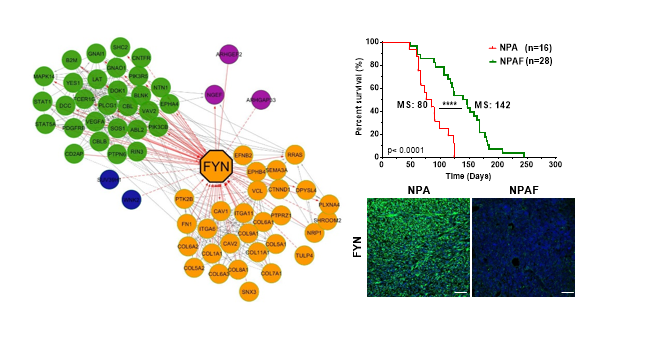The role of the protein FYN in anti-glioma immune responses

High-grade gliomas are aggressive brain tumors with limited treatment options and a poor prognosis. Going beyond conventional surgery, radiation, and chemotherapy, researchers are looking at the microenvironment of tumors, and how certain interactions at the molecular level can inhibit or promote tumor growth. A study published in Neuro-Oncology by U-M Precision Health members Andrea Comba and Pedro Lowenstein and colleagues demonstrates how, in pre-clinical mouse models, the protein FYN, which is abundant in gliomas, suppresses anti-tumor immune responses, making these tumors more aggressive.
“This study discovered how a glioma intracellular signaling pathway inhibits the tumor immune microenvironment to stimulate, indirectly, tumor growth and invasion,” said Lowenstein, MD, PhD, a Professor of Neurosurgery and Cell and Developmental Biology.
“Molecular mechanisms that control the inhibitory immune tumor microenvironment in glioma progression remain poorly understood,” said Comba, PhD, a postdoctoral research fellow in Neurosurgery. “We elucidated a novel role for FYN in glioma initiation and progression. We demonstrated that the non-receptor FYN tyrosine kinase inhibits anti-glioma immunity.” Thus, inhibiting FYN’s expression promotes anti-tumor immune response.
The team moved research on FYN from an in vitro context to genetically engineered mouse models. “Induction of glioma tumors using genetically engineered mouse glioma models in immune-competent mice reproduces better the etiology of human cancer and enables the study of the tumor microenvironment,” said Comba. “Immune-competent” was key—when researchers inhibited FYN in immunocompromised mice, “Fyn knockdown gliomas failed to show differences in survival,” as these mice did not possess adaptive immune systems.
In an editorial accompanying the study, Sachendra S. Bais and Milan G. Chheda state, “This work is important because it begins to connect the dots of how a tumor cell may engage its microenvironment to make it more hospitable for growth…. An important lesson here is that even though in vitro evidence suggests that Fyn does its job in a cell-intrinsic manner, mouse models and context matter and detailed investigations into tumor cell–microenvironment interactions can be much more illuminating.”
Inhibiting FYN has the potential to increase the efficacy of current anti-glioma immunotherapies. “Due to glioma tumors’ heterogeneity, combined target treatments that pair the molecular profile of the tumor with particular therapies will be needed,” said Lowenstein. “We propose that selectively targeting FYN could potentiate the activity of anti-glioma checkpoint inhibitors.”
The team’s next challenge is how to administer such a therapy. “Treatment of glioma has been a challenge due to the inability of different therapeutics agents to cross the blood-brain barrier,” said Comba. “We propose to use special nanoparticles loaded with small interfering RNA (siRNA) that can be systemically administered to deliver their cargo directly to brain tumors. This strategy will be developed in collaboration with Dr. Lahann’s laboratory at U-M’s Biointerfaces Institute. Moreover, we propose to combine this strategy with immune-stimulatory gene therapy. This gene therapy strategy has been pioneered by our laboratory,” said Lowenstein. “A first in human phase I clinical trials utilizing this immune-mediated gene therapy has recently completed accrual at our Institution [ClinicalTrials.gov Identifier: NCT01811992].”


